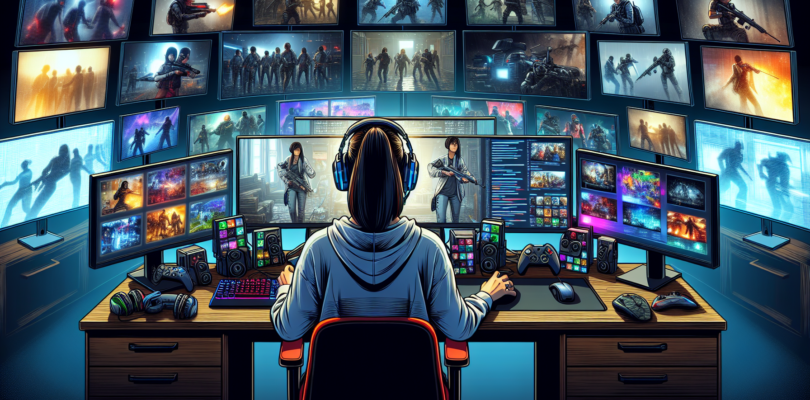Contents
- Introduction
- Panel Type
- Resolution and Aspect Ratio
- Refresh Rate and Response Time
- Color Accuracy and Contrast Ratio
- Size and Curvature
- Other Features
- Conclusion
Introduction
A gaming monitor is an essential piece of equipment for any serious gamer. It can make the difference between a mediocre gaming experience and an immersive one. But with so many different gaming monitors on the market, it can be difficult to know which one is right for you.
This guide will help you choose the best gaming monitor for your needs. We’ll cover everything you need to know, from panel type to resolution to refresh rate.
Panel Type
The first thing you need to consider when choosing a gaming monitor is the panel type. There are three main types of panels used in gaming monitors: TN, IPS, and VA.
* **TN (Twisted Nematic)** panels are the fastest and most affordable of the three types. They offer low response times and high refresh rates, making them ideal for fast-paced games like first-person shooters. However, TN panels have poor viewing angles and color accuracy.
* **IPS (In-Plane Switching)** panels offer the best color accuracy and viewing angles of the three types. They’re also more expensive than TN panels. IPS panels are a good choice for gamers who want a monitor with vibrant colors and wide viewing angles.
* **VA (Vertical Alignment)** panels offer a good compromise between TN and IPS panels. They have faster response times than IPS panels, but not as fast as TN panels. VA panels also have better color accuracy than TN panels, but not as good as IPS panels. VA panels are a good choice for gamers who want a monitor with good overall performance.
Resolution and Aspect Ratio
The resolution of a gaming monitor is the number of pixels that make up the image. The higher the resolution, the sharper the image will be. However, higher resolutions also require more powerful graphics cards to run smoothly.
The most common resolutions for gaming monitors are 1920×1080 (1080p), 2560×1440 (1440p), and 3840×2160 (4K). 1080p is the most affordable resolution, but it’s also the least sharp. 1440p is a good compromise between affordability and sharpness. 4K is the sharpest resolution, but it’s also the most expensive and requires a very powerful graphics card to run smoothly.
The aspect ratio of a gaming monitor is the ratio of the width to the height. The most common aspect ratio for gaming monitors is 16:9. However, some monitors also have ultrawide aspect ratios, such as 21:9. Ultrawide monitors offer a wider field of view, which can be beneficial in some games.
Refresh Rate and Response Time
The refresh rate of a gaming monitor is the number of times per second that the image on the screen is updated. The higher the refresh rate, the smoother the image will be. However, higher refresh rates also require more powerful graphics cards to run smoothly.
The most common refresh rates for gaming monitors are 60Hz, 120Hz, 144Hz, and 240Hz. 60Hz is the standard refresh rate for most monitors. 120Hz and 144Hz are good choices for gamers who want a smoother gaming experience. 240Hz is the highest refresh rate available on gaming monitors, but it’s also the most expensive and requires a very powerful graphics card to run smoothly.
The response time of a gaming monitor is the amount of time it takes for a pixel to change from one color to another. The lower the response time, the less likely you are to see ghosting or motion blur.
Response times are typically measured in milliseconds (ms). The lower the number, the better. The best gaming monitors have response times of 1ms or less.
Color Accuracy and Contrast Ratio
Color accuracy is important for gamers who want to see their games in the most realistic way possible. A monitor with good color accuracy will accurately reproduce the colors that the game developers intended.
Contrast ratio is the difference between the brightest and darkest colors that a monitor can display. A higher contrast ratio will result in a more vibrant image.
Size and Curvature
The size of a gaming monitor is measured in inches, diagonally. The most common sizes for gaming monitors are 24 inches, 27 inches, and 32 inches. 24-inch monitors are the most affordable, but they also have the smallest screens. 27-inch monitors are a good compromise between affordability and screen size. 32-inch monitors offer the largest screens, but they’re also the most expensive.
Curvature is a measure of how much the monitor’s screen curves inward. Curved monitors can provide a more immersive gaming experience, but they’re also more expensive than flat monitors.
Other Features
In addition to the main features discussed above, there are a number of other features that you may want to consider when choosing a gaming monitor. These features include:
* **Adaptive Sync** is a technology that helps to reduce screen tearing and stuttering.
* **HDR (High Dynamic Range)** is a technology that allows monitors to display a wider range of colors and contrast.
* **G-Sync** and **FreeSync** are proprietary technologies from NVIDIA and AMD, respectively, that help to reduce screen tearing and stuttering.
* **USB-C** is a newer type of connection that allows you to connect your monitor to your computer with a single cable.
Conclusion
Choosing the best gaming monitor for your needs can be a daunting task. But by considering the factors discussed in this guide, you can narrow down your choices and find the perfect monitor to enhance your gaming experience.





